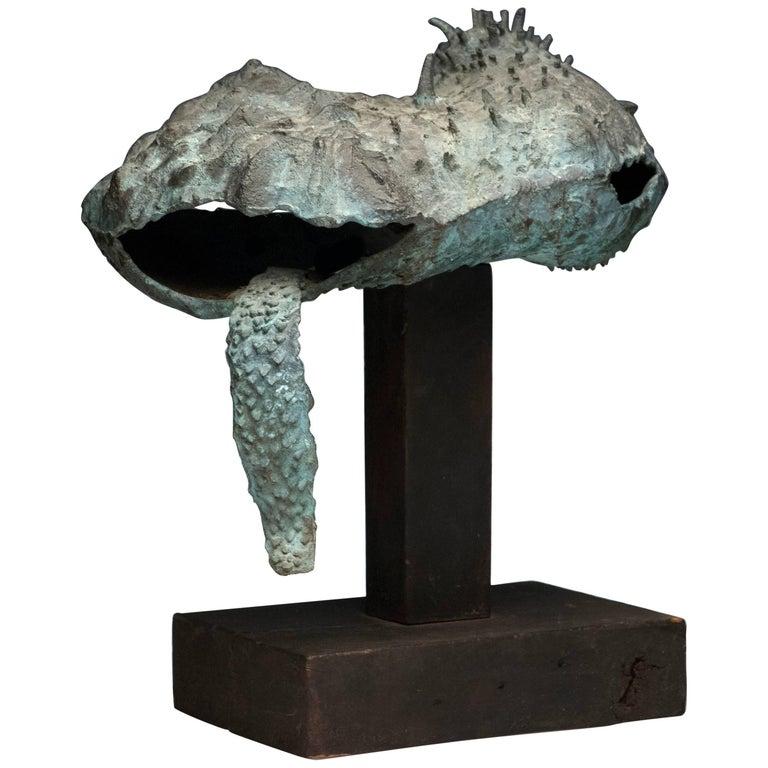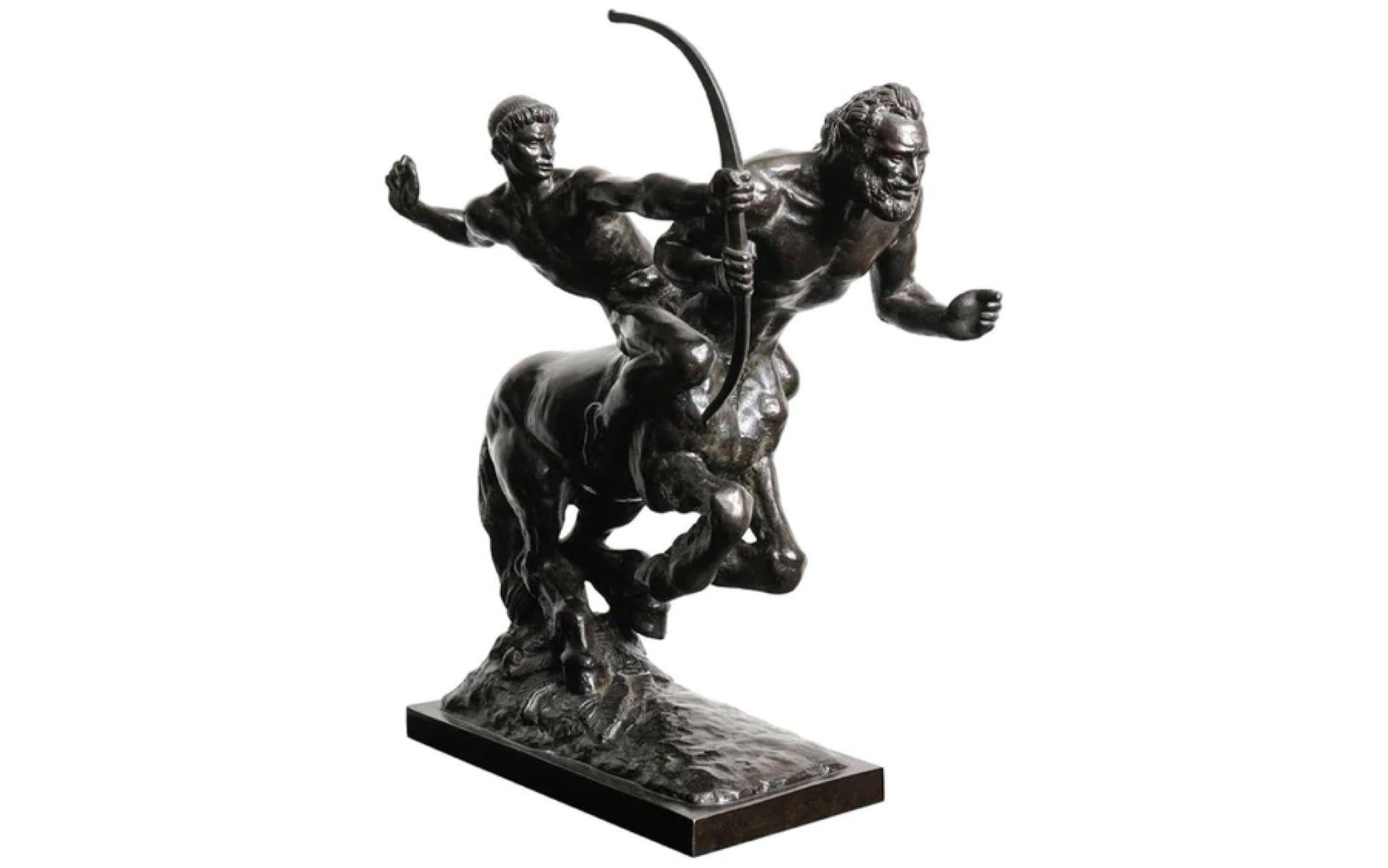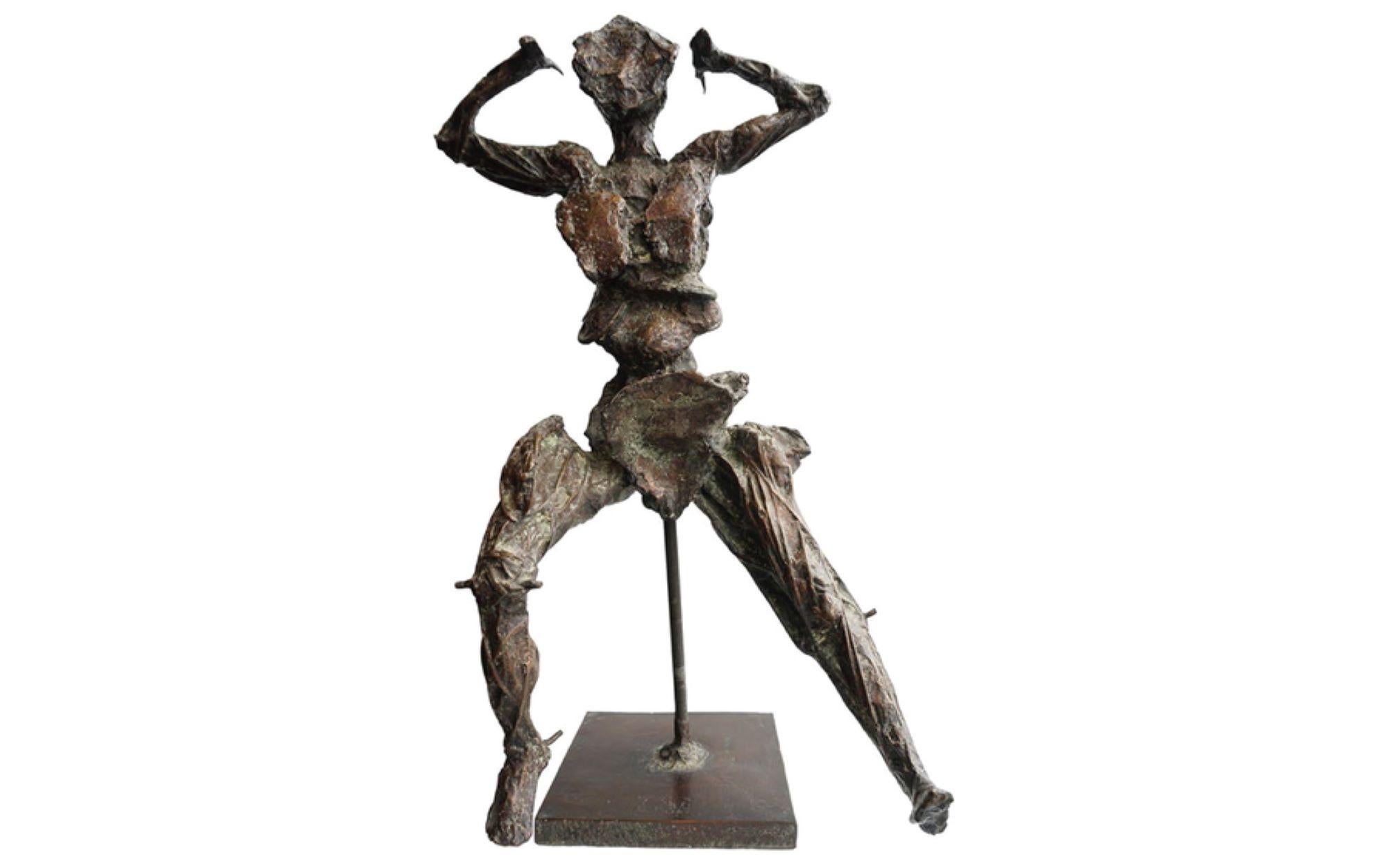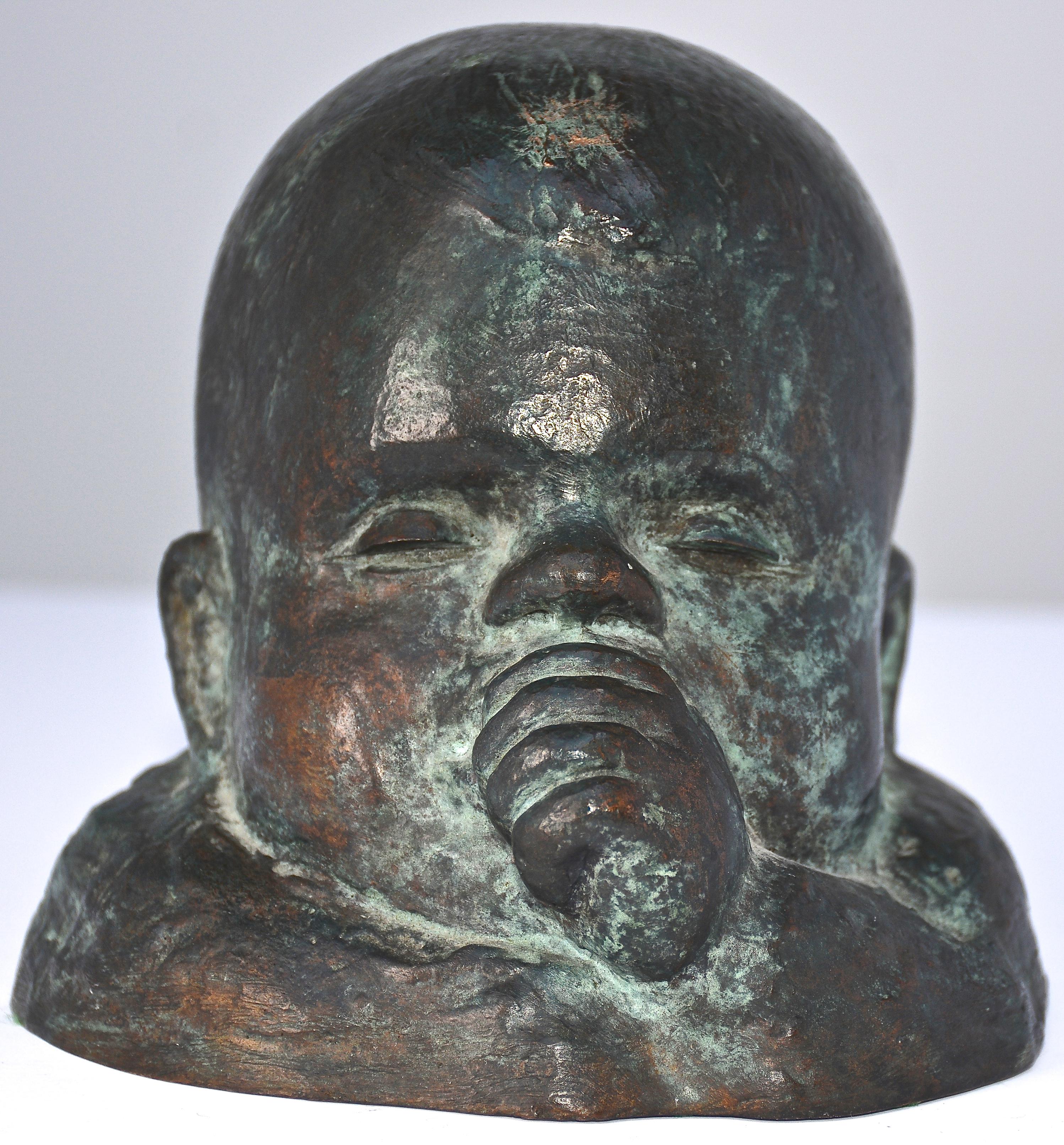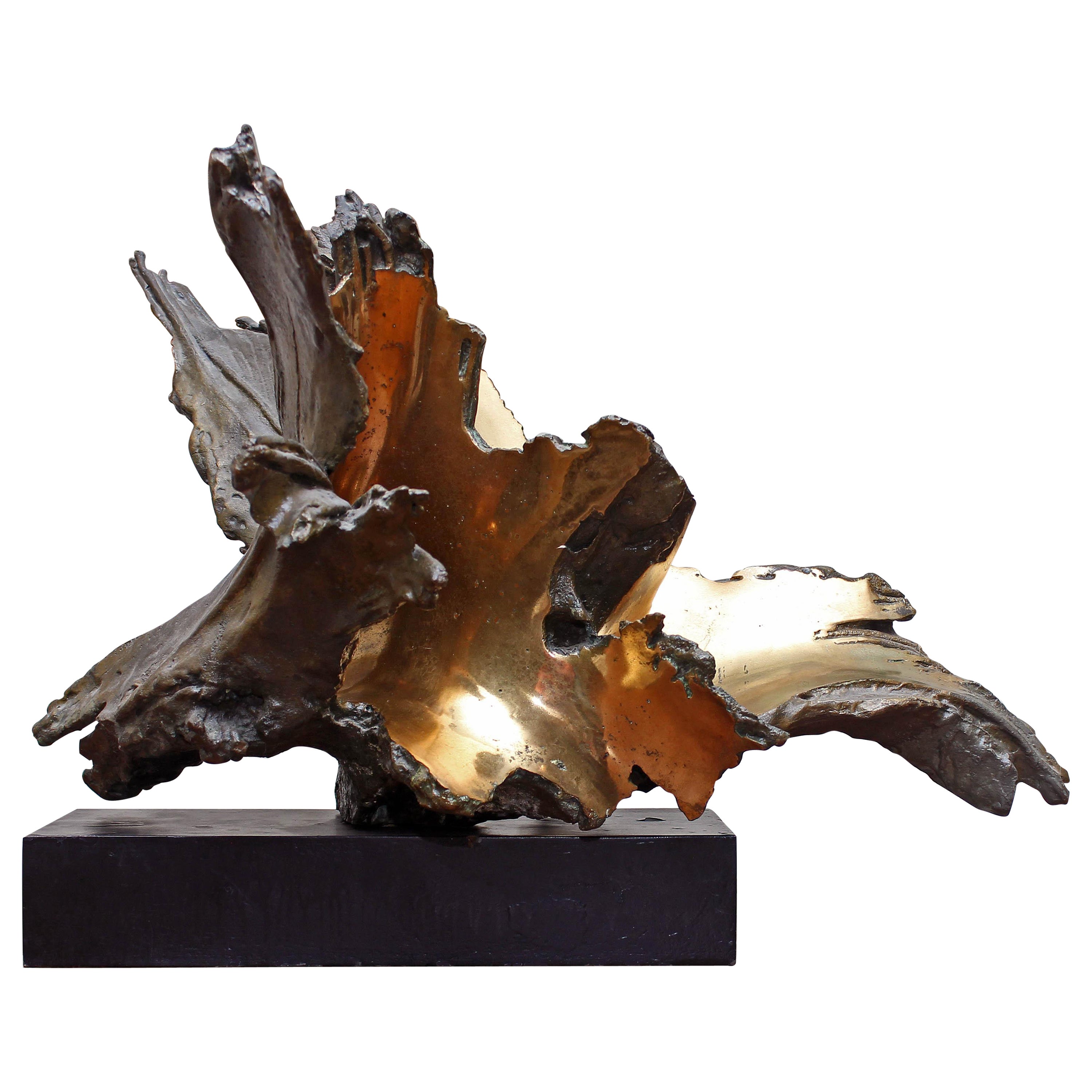Items Similar to Bronze Wall Hanging Sculpture, Verdigris Patina
Want more images or videos?
Request additional images or videos from the seller
1 of 5
Ilana GoorBronze Wall Hanging Sculpture, Verdigris Patina
About the Item
Ilana Goor is an individualistic, autodidactic, intuitive and multifaceted artist. As an artist who knows no boundaries and whose art transcends any conventions, her creations are a blend of vitality and obsession, functional simplicity alongside expressive complexity bordering on surrealism. Her sources of inspiration are neither time nor place-dependent. They create a personal statement, a journey replete with meaning and they succeed in touching and moving people the world over.
Goor was born in Tiberias to an educated and distinguished family of highly respected doctors and artists. She never studied art or design in any formal setting. She developed her artistic techniques on her own from an early age, when she used various parts to create small statues. She is considered to be an international multidisciplinary artist. Her works encompass sculptures, furniture, judaica, lighting fixtures, jewelry and fashion items which are displayed in well known galleries worldwide and are distinguished by their powerful, dominant presence.
She first came to the United States in her 20s and captured the hearts of the locals with her large-buckle belts for men which paved her artistic path in North America. Since then Ilana Goor was requested to install statues in major public locations and exhibited her works in museums throughout Europe, America, Japan and Israel. Ilana Goor designed jewelry, buckles and sold belts to most major department stores in America including I Magnin, Neiman Marcus, Bloomingdale's, Macy's, Saks Fifth Ave. and in Japan.
In 1986 Ilana Goor introduced a collection of iron furniture and accessories to the American marketplace as limited editions signed by the artist.
She was awarded the Roscoe award for Best Design in residential seating in 1988.
Her works are presently displayed in sixteen decorator and designer showrooms throughout the United States. Her iron furniture collection was displayed in the Israel Museum, Jerusalem in1987 and in 1993 Ilana Goor introduced her collection of furniture in Japan along with her second collection of jewelry.As a result, Goor has been able to launch her impressive talents and has dedicated her main efforts to industry. Goor's first one-woman exhibition was held in 1972 at the California Museum of Science and Industry in Los Angeles. Since then, her works of art have been exhibited in numerous museums both in Israel and abroad, e.g. the Tel Aviv Museum of Art, the Museum of 20th Century Art in Vienna, and more.
One of the high points in Goor's career in the field of design was in 1986 when she won the prestigious Peres Roscoe Design prize. Her signature, which is identified in all her work can also be seen in a number of locations in Israel, such as the moving sculpture, Never Again which is on display at Yad Vashem in Jerusalem and the Woman in the Wind sculpture that is close to the Charles Clore park in Tel Aviv.
- Creator:Ilana Goor (1936, Israeli)
- Dimensions:Height: 7 in (17.78 cm)Width: 26 in (66.04 cm)Depth: 5 in (12.7 cm)
- Medium:
- Movement & Style:
- Period:
- Condition:Measures 35 inches across including the wood.
- Gallery Location:Surfside, FL
- Reference Number:1stDibs: LU38212130112
About the Seller
4.9
Platinum Seller
These expertly vetted sellers are 1stDibs' most experienced sellers and are rated highest by our customers.
Established in 1995
1stDibs seller since 2014
1,541 sales on 1stDibs
Typical response time: 1 hour
- ShippingRetrieving quote...Ships From: Surfside, FL
- Return PolicyA return for this item may be initiated within 3 days of delivery.
More From This SellerView All
- Bronze Sculpture Relief Rhinoceros with Tree American Modernist Leonard BaskinBy Leonard BaskinLocated in Surfside, FLLeonard Baskin (1922-2000) Fruitfulness From Permanence signed, edition 3/8 Bronze, 1967 19.5 X 16 X 1.5 inches The inspiration for this work was a Bernini sculpture Elephant Carrying Obelisk, a 17th century commission outside an ancient temple dedicated to Minerva the goddess of wisdom. It was one of several works from 1967 on a theme of continuity Leonard Baskin (August 15, 1922 – June 3, 2000) was an American sculptor, illustrator, wood-engraver, printmaker, graphic artist, writer and teacher. Baskin was born in New Brunswick, New Jersey. While he was a student at Yale University, he founded Gehenna Press, a small private press specializing in fine book production. From 1953 until 1974, he taught printmaking and sculpture at Smith College in Northampton, Massachusetts. Subsequently Baskin also taught at Hampshire College in Amherst, Massachusetts. He lived most of his life in the U.S., but spent nine years in Devon at Lurley Manor, Lurley, near Tiverton, close to his friend Ted Hughes, for whom he illustrated Crow. Sylvia Plath dedicated Sculpto to Leonard Baskin in her famous work, The Colossus and Other Poems (1960). The Funeral Contege (1997) bronze, Franklin Delano Roosevelt Memorial, Washington, D.C. His public commissions include a bas relief for the Franklin Delano Roosevelt Memorial and a bronze statue of a seated figure, erected in 1994 for the Holocaust Memorial in Ann Arbor, Michigan. His works are owned by many major museums including the Metropolitan Museum of Art, the Museum of Fine Arts, Boston, the Museum of Modern Art, the Art Institute of Chicago, the Boca Raton Museum of Art, the British Museum, the Honolulu Museum of Art, the Udinotti Museum of Figurative Art and the Vatican Museums. The archive of his work at the Gehenna Press was acquired by the Bodleian Library at Oxford, England, in 2009. The McMaster Museum of Art in Hamilton, Ontario owns over 200 of his works (some religious and biblical), most of which were donated by his brother Rabbi Bernard Baskin. Contemporary Religious Imagery in American Art. Catalog for an exhibition held at the Ringling Museum of Art, March 1-31, 1974. Artists represented: David Aronson, Leonard Baskin, Max Beckmann, Hyman Bloom, Fernando Botero, Paul Cadmus, Marvin Cherney, Arthur G. Dove, Philip Evergood, Adolph Gottlieb, Jonah Kinigstein, Arman, Rico Lebrun, Jack Levine, Louise Nevelson, Barnett Newman, Abraham Rattner, Ben Shahn, Mark Tobey, Max Weber, William Zorach and others.In 1955, he was one of eleven New York artists featured in the opening exhibition at the Terrain Gallery, they showed many great artists, Chaim Koppelman, for many years, headed the gallery's Print Division; printmakers such as Will Barnet, Leonard Baskin, Robert Conover, Edmond...Category
20th Century Modern Figurative Sculptures
MaterialsBronze
- Bronze Sculpture Figure with Beast American Modernist Leonard Baskin Museum ArtBy Leonard BaskinLocated in Surfside, FLLeonard Baskin, American 1922-2000 Homage to the Un-American Activities Committee Bronze relief sculpture plaque This is not editioned, nor signed or numbered, on the piece but according to the catalog there was 12 or less. A number of these are in museum and university art collections and one of them was exhibited at MoMA NY. This was done to commemorate the communist witch hunts of the Mccarthy era. An important, historic piece. Leonard Baskin (August 15, 1922 – June 3, 2000) was an American sculptor, illustrator, wood-engraver, printmaker, graphic artist, writer and teacher. Baskin was born in New Brunswick, New Jersey. While he was a student at Yale University, he founded Gehenna Press, a small private press specializing in fine, small edition, book production. From 1953 until 1974, he taught printmaking and sculpture at Smith College in Northampton, Massachusetts. Subsequently Baskin also taught at Hampshire College in Amherst, Massachusetts. He lived most of his life in the U.S., but spent nine years in Devon at Lurley Manor, Lurley, near Tiverton, close to his friend Ted Hughes, for whom he illustrated Crow. Sylvia Plath dedicated Sculpto to Leonard Baskin in her famous work, The Colossus and Other Poems (1960). The Funeral Cortege (1997) bronze, Franklin Delano Roosevelt Memorial, Washington, D.C. His public commissions include a bas relief for the Franklin Delano Roosevelt Memorial and a bronze statue of a seated figure, erected in 1994 for the Holocaust Memorial in Ann Arbor, Michigan. His works are owned by many major museums including the Metropolitan Museum of Art, the Museum of Fine Arts, Boston, the Museum of Modern Art, the Art Institute of Chicago, the Boca Raton Museum of Art, the British Museum, the Honolulu Museum of Art, the Udinotti Museum of Figurative Art and the Vatican Museums. The archive of his signed work at the Gehenna Press was acquired by the Bodleian Library at Oxford, England, in 2009. The McMaster Museum of Art in Hamilton, Ontario owns over 200 of his works (some religious and biblical), most of which were donated by his brother Rabbi Bernard Baskin. Contemporary Religious Imagery in American Art. Catalog for an exhibition held at the Ringling Museum of Art, March 1-31, 1974. Artists represented: David Aronson, Leonard Baskin, Max Beckmann, Hyman Bloom, Fernando Botero, Paul Cadmus, Marvin Cherney, Arthur G. Dove, Philip Evergood, Adolph Gottlieb, Jonah Kinigstein, Arman, Rico Lebrun, Jack Levine, Louise Nevelson, Barnett Newman, Abraham Rattner, Ben Shahn, Mark Tobey, Max Weber, William Zorach and others.In 1955, he was one of eleven New York artists featured in the opening exhibition at the Terrain Gallery, they showed many great artists, Chaim Koppelman, for many years, headed the gallery's Print Division; printmakers such as Will Barnet, Leonard Baskin, Robert Conover, Edmond Casarella...Category
1950s Modern Figurative Sculptures
MaterialsBronze
- Bronze Female Nude Sculpture Modernist, WPA, New York Chelsea Hotel ArtistBy Eugenie GershoyLocated in Surfside, FLEugenie Gershoy (January 1, 1901 – May 8, 1986) was an American sculptor and watercolorist. Eugenie Gershoy was born in Krivoy Rog, Russia (Krivoi Rog, Ukraine) and emigrated to New York City in the United States as a child in 1903. Considered somewhat of a child prodigy, Gershoy was copying Old Master drawings at the age of 5. Her interest and talent in art was encouraged from a very young age. Aided by scholarships, she studied at the Art Students League under Alexander Stirling Calder, Leo Lentelli, Kenneth Hayes Miller, and Boardman Robinson. Around this time, she created a group of portrait figurines of her fellow artists, including Arnold Blanch, Lucile Blanch, Raphael Soyer, William Zorach, Concetta Scaravaglione, and Emil Ganso, which were exhibited as a group at the Whitney Museum of American Art. At age 17, she was awarded the Saint-Gaudens Medal for fine draughtsmanship. Early in her career she became an active member of the Woodstock art colony. In Woodstock she experimented by sculpting in the profusion of indigenous materials that she found. Working with fieldstone, oak and chestnut, Gershoy created works based on classic formulae. As she became more interested in the dynamism of everyday life, she found that these materials and her idiom were too restrictive. By the time Gershoy came to Woodstock in 1921 her own individual artistic style was already evident in her sculptures. Eugenie Gershoy worked in stone, bronze, terracotta, plaster and papier-mache. Gershoy’s sculptures were mainly figurative in nature and many of her artist peers such as Carl Walters, Raphael and Moses Soyer, William Zorach and Lucille Blanch, became her subjects. Eugenie Gershoy’s works on paper should not be overlooked. She was the winner of the Gaudens Medal for Fine Draughtsmanship at the tender age of 17. Gershoy married Jewish Romanian-born artist Harry Gottlieb. In the late 1920s and early 1930s, the pair kept a studio in Woodstock, New York. There, Gershoy was influenced by sculptor John Flanagan, who lived and worked nearby. From 1936 to 1939, Gershoy worked for the WPA Federal Art Project. She collaborated with Max Spivak on murals for the children's recreation room of the Queens Borough Public Library in Astoria, New York. She developed a mixture of wheat paste, plaster, and egg tempera, which she used in polychrome papier-mâché sculptures; she was the only New York sculptor to work in polychrome at this time. She also designed cement and mosaic sculptures of animals and figures to be placed in New York City playgrounds. Alongside others employed by the FAP, she participated in a sit-down strike in Washington, DC, to advocate for better pay and improved working conditions for the projects' artists. Gershoy's first solo exhibition was held at the Robinson Gallery in New York in 1940. She moved to San Francisco in 1942, and began teaching ceramics at the California School of Fine Arts in 1946. In 1950, she studied at the artists' colony at Yaddo. Gershoy traveled extensively throughout her life. She visited England and France in the early 1930s, and worked in Paris in 1951. She traveled to Mexico and Guatemala in the late 1940s, and also toured Africa, India, and the Orient in 1955. In 1977, Gershoy dedicated a sculpture to Audrey McMahon, who was actively involved in the creation of the Federal Art Project and served as its regional director in New York, in recognition of the work McMahon provided struggling artists in the 1930s. Gershoy's work is in the collections of the Whitney Museum of American Art, the Metropolitan Museum of Art, and the Smithsonian American Art Museum. Her papers are held at Syracuse University Grant Arnold introduced her to lithography in 1930 and Gershoy depicted many scenes of Woodstock artists and their daily activities through this medium. From 1942 to 1966 Gershoy lived and painted in San Francisco where she taught at the San Francisco Art Institute. She traveled extensively, filling sketchbooks with scenes of Mexico, France, Spain, Africa and India. During her later years Eugenie Gershoy returned to New York City and concentrated on numerous well received exhibitions. Her last exhibition in at Sid Deutsch Gallery included many of the sculptures that were later exhibited in the Fletcher Gallery. John Russell, former chief critic of fine arts for the New York Times, writes about the 1986 Sid Deutsch exhibition: “As Eugenie Gershoy won the Saint-Gaudens Medal for fine draftsmanship as long ago as 1914 and since 1967 has had 15 papier-mache portrait figures suspended from the ceiling of the lobby of the Hotel Chelsea, she must be ranked as a veteran of the New York scene. Her present exhibition includes not only the high-spirited papier-mache sculptures for which she is best known but a group of small portraits of artists, mostly dating from the 30’s, that is strongly evocative.” Eugenie Gershoy is an artist to take note of for several reasons. She was a woman who received great awards and recognition during a time when most female artists were struggling to hold their own against their male counterparts. As a young girl she won a scholarship to the Arts Student League where she met Hannah Small...Category
Mid-20th Century American Modern Nude Sculptures
MaterialsBronze
- Mexican Art Abstract Brutalist Biomorphic Bronze Sculpture Mathias GoeritzBy Mathias GoeritzLocated in Surfside, FLMathias Goeritz (German Mexican, 1915-1990) Bronze sculpture Signed and numbered Dimensions: (approximate) Height: 10 inches, Width: 4 inches, Depth: 2 inches. This is a cast bronze sculpture in an amorphous figure shape, quite heavy. Reminiscent of the biomorphic sculpture of Hans Jean Arp. This came from an estate and bears his signature It is not dated. there is no accompanying documentation. it is priced accordingly. Werner Mathias Goeritz Brunner (Danzig, Germany, April 4th, 1915/ now Gdansk, Poland – Mexico City, Mexico; August 4th, 1990). Mathias Goeritz has had several gallery and museum exhibitions, including at the Museo Nacional Centro de Arte Reina Sofía and at the Museo Experimental El Eco. Numerous works by the artist have been sold at auction, including 'MENSAJE' sold at Sotheby's New York 'Latin American Modern Art' in 2015 for $466,000. There have been Several articles about Mathias Goeritz, including 'LACMA remaps Latin America' written by Suzanne Muchnic for the Los Angeles Times. Painter, sculptor and Mexican architect associated with the trend of constructive abstraction. He studied medicine at the University of Berlin, but this only lasted a year. The concerns of the young student were aesthetic in nature so he he studied figurative drawing at the Berlin Charlottenburg School of Art. Some of his friends and colleagues were the sculptor Ernst Barlach, painter George Grosz and draughtsman Kaethe Kollwitz. Goeritz studied philosophy and history of art, discipline in which earned a doctorate. He travelled in France, Switzerland, Czechoslovakia, Poland, Austria and Italy, among other countries. It is known that he left Germany to live in Tetuan, Morocco in 1941 and then Granada, Spain in 1945. In 1946 he had a large exhibition in the Sala Clan in Madrid under the pseudonym "Mago". Two years later, living in Santilla del Mar, Spain he was a founder of the Escuela de Altamira. The following year he married Marianne Gast, writer and his companion for more than fifteen years. In Spain followed his artistic work by important artists of the avant-garde. Of Jewish descent, he found refuge from the Second World War in Mexico where in 1949 he was invited by Ignacio Diaz Morales to be a part of the faculty of the School of Architecture at the Universidad de Jalisco. In 1953 he wrote the "Manifiesto de la Arquitectura Emocional" (The Emotional Architecture Manifesto), where he points out that only achieving true emotions from architecture can it then be considered an art form. In Mexico he entered controversy with the artistic stablishment of that country; in an open letter, Diego Rivera and David Alfaro Siqueiros described him as "an impostor without the most insignificant talent and preparation" to be an artist. Despite this, in 1957 he was elected director of visual design of the National School of architecture This same year he founded the Museo del Eco in Mexico City. In 1961 Goeritz participated at the Galería Antonio Souza in a group exhibition, Los hartos, for which he published another manifesto. Other participants included Jose Luis Cuevas and Pedro Friedeberg, with whom he was instrumental in establishing abstraction and other modern trends in Mexico.His work is included in the Gelman Collection of modern and contemporary Mexican art based in Cuernavaca, Mexico. Established by Jacques and Natasha Gelman in 1943 as a private collection. it includes many iconic works by major Mexican Modernists including Frida Kahlo, Diego Rivera, David Alfaro Siqueiros, Leonora Carrington, Rufino Tamayo and Francisco Toledo, Lola Alvarez...Category
20th Century Modern Abstract Sculptures
MaterialsBronze
- Small Bronze Sculpture Cast Head After Rodin "Petite tete au nez retrousse"By Auguste RodinLocated in Surfside, FL(after) Auguste Rodin Posthumous cast "Petite tete au nez retroussé" Featuring a bust of a woman. Limited edition bronze is mounted on a marble base and is signed on the lower right. Great detail. Dimensions: approx. 7-1/4" tall x 5" across x 5" deep with base Foundry mark on the reverse, #13 of 299 produced. François Auguste René Rodin (1840 – 1917) was a French sculptor generally considered the founder of modern sculpture. Rodin possessed a unique ability to model a complex, turbulent, and deeply pocketed surface in clay. He is known for such sculptures as The Thinker, Monument to Balzac, The Kiss, The Burghers of Calais, and The Gates of Hell. He modeled the human body with naturalism, and his sculptures celebrate individual character and physicality. Although Rodin was sensitive to the controversy surrounding his work, he refused to change his style, and his continued output brought increasing favor from the government and the artistic community. Rodin became the preeminent French sculptor of his time. By 1900, he was a world-renowned artist. Wealthy private clients sought Rodin's work after his World's Fair exhibit, and he kept company with a variety of high-profile intellectuals and artists. His student, Camille Claudel, became his associate, lover, and creative rival. Rodin's other students included Antoine Bourdelle, Constantin Brancusi, and Charles Despiau. Rodin entered the studio of Albert-Ernest Carrier-Belleuse, a successful mass producer of objets d'art. Rodin worked as Carrier-Belleuse' chief assistant until 1870, designing roof decorations and staircase and doorway embellishments. With the arrival of the Franco-Prussian War, Rodin was called to serve in the French National Guard, but his service was brief due to his near-sightedness. Rodin took classes with animal sculptor Antoine-Louis Barye. The teacher's attention to detail and his finely rendered musculature of animals in motion significantly influenced Rodin. Rodin won the 1880 commission to create a portal for a planned museum of decorative arts. Rodin dedicated much of the next four decades to his elaborate Gates of Hell, an unfinished portal for a museum that was never built. Many of the portal's figures became sculptures in themselves, including Rodin's most famous, The Thinker and The Kiss. With the museum commission came a free studio, granting Rodin a new level of artistic freedom. By 1900, Rodin's artistic reputation was established. Gaining exposure from a pavilion of his artwork set up near the 1900 World's Fair (Exposition Universelle) in Paris, he received requests to make busts of prominent people internationally, As Rodin's fame grew, he attracted many followers, including the German poet Rainer Maria Rilke, and authors Octave Mirbeau, Joris-Karl Huysmans, and Oscar Wilde. Rodin and Beuret's modest country estate in Meudon, purchased in 1897, was a host to such guests as King Edward, dancer Isadora Duncan, and harpsichordist Wanda Landowska. He left Beuret in Meudon and began an affair with the American-born Duchesse de Choiseul. From 1910, he mentored the Russian sculptor, Moissey Kogan...Category
20th Century Modern Figurative Sculptures
MaterialsBronze
- Bronze Sculpture American Modernist Art Stanley Bleifeld Girl with Bass or CelloBy Stanley BleifeldLocated in Surfside, FLRetaining a fine patina and in overall good condition. Signed with initials SB. I believe the edition size was 7 But I cannot find a mark. Stanley Bleifeld (1924 – 2011) was an American sculptor. Stanley Bleifeld was born and raised in Brooklyn, New York, Bleifeld earned bachelor of fine arts, bachelor of science in education and in 1949 a master of fine arts degree in painting at Tyler School of Art of Temple University. After a trip to Rome in 1959 or 1960 he gave up painting for sculpture. He began his fine-art career as a painter. However, a visit to Italy and exposure to the bronzes of Donatello, Michelangelo, and Ghiberti changed his direction He worked with the Art Foundry of Massimo del Chiaro and alongside artists such as Lucchesi, Harry Marinsky, Fernando Botero, Igor Mitoraj and Ivan Theimer. Many of his early pieces were religious subjects, and reflected both painting and sculptural techniques in bas reliefs* that had "liquid landscapes in undulating reliefs and free-flowing portraits reminiscent of classical fragments" (166-167). He later turned from these abstract pieces to more realistic figures in bronze. Bleifeld was a National Academician in Sculpture, and a member of the National Academy of Design, and helped set policy for that organization. He was also President of the National Sculpture Society. Past presidents of the society have included John Quincy Adams Ward, James Earle Fraser, Chester Beach, Wheeler Williams, Leo Friedlander, Neil Estern, and Cecil de Blaquiere Howard. The first woman to gain admission into the NSS was Theo Alice Ruggles Kitson, in 1893. She was followed a few years later by Enid Yandell and Bessie Potter Vonnoh in 1898; Janet Scudder in 1904; Anna Hyatt Huntington in 1905 and Evelyn Longman and Abastenia St. Leger Eberle in 1906. In 1946, Richmond Barthé was likely the first African-American to be admitted. In 1994, the NSS held their first exhibition outside the United States at the Palazzo Mediceo Di Seravezza in Italy. Titled “100 Years of the National Sculpture Society of the United States of America in Italy” it ran from the 16th of July through the 4th of September and was curated by Nicky and Stanley Bleifeld along with Costantino Paolicchi, Lodovico Gierut and Paolo Giorgi. Among the 60 notable American sculptors whose work was selected for the exhibition were Stanley Bleifeld, Andrew DeVries, Neil Estern, Leonda Finke, Bruno Lucchesi, Barbara Lekberg...Category
1970s American Modern Figurative Sculptures
MaterialsBronze
You May Also Like
- Archer and CentaurBy Pierre TraverseLocated in New York, NYPierre Traverse Archer and Centaur c. 1969 Bronze 17 x 16 x 7 in, 45 x 41 x 17 cm It is signed by the artist and is an "Epreuve d'artiste" (EA) 3/4 Edition 3/4Category
1960s Modern Figurative Sculptures
MaterialsBronze
- WomanBy Wang KepingLocated in New York, NYWang Keping Woman 2010 Bronze 17 x 8 x 8 in, 44 x 22 x 22 cm Signed: Fonderie de la Plaine Private Collection of Didier Marien From the essence of natural surfaces, Wang Ke...Category
21st Century and Contemporary Modern Sculptures
MaterialsBronze
- Personnage en MouvementBy Jean-Robert IpoustéguyLocated in New York, NYJean-Robert Ipoustéguy Personnage en mouvement 1976 Bronze 25 x 12 x 12 in, 63 x 30 x 30 cm Dated and signed "Ipoustéguy" Edition 5/8 Private Collection of Didier Marien ...Category
1970s Modern Abstract Sculptures
MaterialsBronze
- Latin American Raúl Valdivieso Bronze Organic Abstract SculptureBy Raúl ValdiviesoLocated in Washington, DCAppealing bronze organic sculpture by Latin American sculptor Raúl Valdivieso (Chilean, 1931-1993). Valdivieso is known for his reinterpretation of the...Category
1960s Modern Abstract Sculptures
MaterialsBronze
- Victor Salmones Signed Bronze Bust of a Young ChildBy Victor SalmonesLocated in Los Angeles, CAAn untitled signed bronze sculpture by the Mexican artist, Victor Salmones (1937 - 1989) from an edition of 10. Numbered 1 of 10. Signature "Victor Salmones. 1/10" in cast. In excellent original condition. Victor Salmones (1937-1989) was the most widely known sculptor living and working in Mexico during his lifetime. His sculptures won him universal acclaim and are held in the collections of museums, corporations, cities, universities and private collectors in some 30 countries. During his career, he was highly sought after and increasingly involved in the execution of commissions for major public works around the world. Salmones developed his love and talent for creating sculpture by working with clay in high school. He attended the Instituto de Bellas Artes (Mexican National Institute of Fine Arts), where he was an apprentice to the Bauhaus master, Otto Hoffman. He was trained to use the exacting, age-old lost wax method of casting and worked principally in bronze. Hoffman's encouragement led to the opening of Victor's own sculpture workshop in Cuernavaca in 1966. In 1967, Salmones’ fluid bronze “Adam” won first prize at the Biennale Exposition of the National Museum of Modern Art. His work continued to win the highest critical acclaim at subsequent Biennale expositions, and in 1971, over hundreds of entries, his life-size bronze Narcissus...Category
1970s Modern Figurative Sculptures
MaterialsBronze
- Bronze Sculpture "Furnace Flowers"By Francesco SomainiLocated in Rochester, NYBronze sculpture Polished and patinated bronze sculpture. "Furnace Flowers" by mid century modern Italian sculptor Francesco Somaini (Italy 1926-...Category
Mid-20th Century Modern Abstract Sculptures
MaterialsBronze
Recently Viewed
View AllMore Ways To Browse
Patina Sculpture
Iron Patina
Sculptured Lighting
Bronze Patina Sculpture
Vintage Bronze Art Sculptures Vintage Art Sculptures
Bronze Sculpture Vintage Art Sculptures
Small Hanging
Hanging Sculpture
Family Bronze
Bronze Age Vintage
Hanging With Sculpture
Wall Hanging Sculptures
Wall Hanging Sculpture
Bronze People
Large Japanese Sculpture
Hanging Bronze
Bronze Parts
Japan Bronze Sculpture
